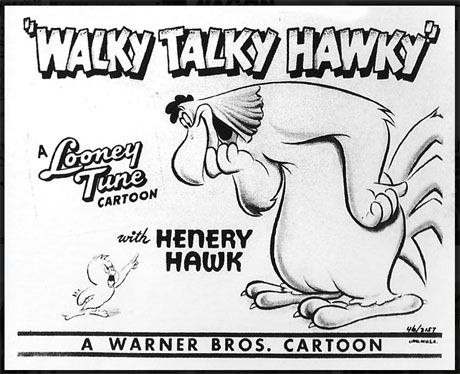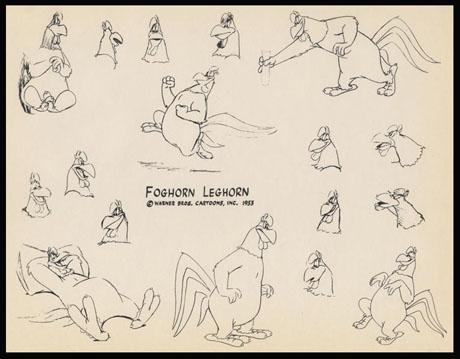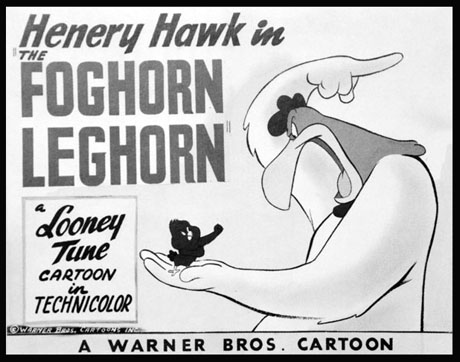In his most famous quote, actor Konstantin Stanislavski once said: “There are no small parts, only small actors.” As hard as it is to imagine, this is true of none other than Foghorn Leghorn. The loud, overbearing, blustery rooster made his first appearance in the 1946 Warner Bros. Cartoon short, Walky Talky Hawky. He wasn’t the star of that short, that was Henery Hawk, but Foghorn’s very animated appearance made such an indelible impact on audiences, he would soon be the standout star.

Foghorn Leghorn’s personality seemed to be based on a popular radio character of the time, “Senator Claghorn of Bighorn,” played by actor Kenny Delmar on The Fred Allen Show. The voices of both characters are almost identical, particularly certain vocal traits – “I say,” followed by repeated dialogue, as well as “Pay attention when I’m talking to you, son” – but there were also other influences for the character.
Legendary director Robert McKimson, who directed Walky Talky Hawky and first brought Foghorn to the screen, noted another character, the Sherriff, on the show Blue Monday Jamboree was also an influence. Vocal genius Mel Blanc, who provided Foghorn’s voice, actually credited a character from an old vaudeville show he had seen as a young boy. (Please read Keith Scott’s definitive article on Foghorn Leghorn’s voice HERE).
These inspirations came together to form one of the most bombastic characters in the Warner Bros. canon.

Foghorn’s first cartoon short, Walky Talky Hawky, (released on August 31, 1946) follows a plot in which young Henery Hawk finds out that he is a chicken hawk and heads off to find a chicken (which he has never seen before).
Meanwhile, in the barnyard, Foghorn faces off against the Barnyard Dawg, his recurring foe. Their “back-and-forth” follows what would become a familiar pattern: Foghorn hits the Dawg with a paddle, angering the dog, who then chases after Foghorn. However, the poor Dawg is attached to the doghouse by a leash, which eventually chokes him, “yanking” him backward.
Henery enters the barnyard, meeting Foghorn, who convinces the little hawk that Barnyard Dawg is a chicken, luring Henery into his tortuous plans for the Dawg. However, the Dawg gets loose from his doghouse, and a free-for-all ensues between him and Foghorn, which then spills over into a stable and involves a horse.
The short ends with Henery capturing all three- dog, rooster, and horse – carrying them away and mimicking Foghorn, as he says, “One of these things, I say, one of these things has got the be a chicken!”

This would become a recurring story line for many of Foghorn’s future shorts.
There were some variations: Sylvester joined the proceedings in 1947’s Crowing Pains; in 1953’s Of Rice and Hen, Foghorn meets Miss Prissy, the skinny, spinster chicken who wants to wed the rooster, and in Little Boy Boo, Foghorn comes up against Miss Prissy’s son, a petite chick named Egghead, jr., bookish with an oversized head, he was a wonder of character design.
In each of these shorts, Foghorn would display what would become his expected, usual character traits, such as singing “Camptown Races” and his unique speech patterns: “That’s a joke, boy! You missed it! It went right past you.” Or “Look at me when I’m talking, son.”
This all came together as one of the most memorable creations to emerge from Warner Bros. And, seventy-eight years later, knowing what we all know about Foghorn Leghorn, he’d be the first to tell us the same.


 Michael Lyons is a freelance writer, specializing in film, television, and pop culture. He is the author of the book, Drawn to Greatness: Disney’s Animation Renaissance, which chronicles the amazing growth at the Disney animation studio in the 1990s. In addition to Animation Scoop and Cartoon Research, he has contributed to Remind Magazine, Cinefantastique, Animation World Network and Disney Magazine. He also writes a blog, Screen Saver: A Retro Review of TV Shows and Movies of Yesteryear and his interviews with a number of animation legends have been featured in several volumes of the books, Walt’s People. You can visit Michael’s web site Words From Lyons at:
Michael Lyons is a freelance writer, specializing in film, television, and pop culture. He is the author of the book, Drawn to Greatness: Disney’s Animation Renaissance, which chronicles the amazing growth at the Disney animation studio in the 1990s. In addition to Animation Scoop and Cartoon Research, he has contributed to Remind Magazine, Cinefantastique, Animation World Network and Disney Magazine. He also writes a blog, Screen Saver: A Retro Review of TV Shows and Movies of Yesteryear and his interviews with a number of animation legends have been featured in several volumes of the books, Walt’s People. You can visit Michael’s web site Words From Lyons at: 






















Robert McKimson’s directorial style was well suited to the Foghorn Leghorn cartoons. His skilled animation of expressive gestures and body language helped punctuate the rhythm and cadence of dialogue that, in other hands, might have come across as excessively wordy and redundant.
Another notable guest star was Foggy’s old college chum Rhode Island Red, played to obnoxious perfection by Daws Butler in “Raw! Raw! Rooster!”
One of the weirdest episodes of The Looney Tunes Show was “The Foghorn Leghorn Story”, in which Foggy — by now a successful if eccentric multimillionaire — makes a movie of his life’s story, starring Daffy Duck in the title role. Many years earlier, Daffy had played a novelty salesman in a very funny Foghorn Leghorn cartoon, “The High and the Flighty”.
Anyone else feel like chicken tonight?
The Foghorn Leghorn cartoons have got to be among the funniest cartoons produced by Warner Bros. I recall laughing till the tears came in watching some of these cartoons. Particularly the interactions with the dog. And with Miss Prissy’s son. Interesting how such a blustering character can be so endearing and empathetic while at the same time being so off-putting. Yet we pull for him more often than not.
Henery Hawk enjoyed a lengthy career in comic books, particularly when paired with his friend Ollie Owl, who served as the voice of common sense. His character seemed a little more developed on the page than on the screen, although there are priceless moments in his appearances in both media. He’s another character who should be dislikable but manages to be endearing, perhaps because of his dogged determination to get himself a chicken one way or another.
My favorite recurring gag in these cartoons has to be when the dog runs out of leash and gets caught up short. That always made me laugh.
To this day, I still have not actually heard the Senator Claghorn character, so to me it almost seems like Mel Blanc invented foghorn Leghorn from a composite of the various radio personalities. I’ve listened to that voice develop into what it is and what we know as foghorn Leghorn. he definitely made his own. Just as he combined two voices to get the proper bugs bunny that we know and love right now, it took a composite of a few characters to create that Rocus rooster.
The “Senator Claghorn” character was voiced by Kenny Delmar in the “Allen’s Alley” segment of The Fred Allen Show on radio starting in 1944 and continuing until the end of his series in 1949; for some reason, “Senator Claghorn” was the first stop through that particular thoroughfare of the imagination, with pun-filled gags commenting on the politics of the time.
Try the Internet Archive for starters, or even sites specialist in Old-Time Radio.
Jack “Rube” Clifford played “The Sheriff” on that long-ago radio show. Here you can see “Rube” in action.
https://www.youtube.com/watch?v=A_kydIlHcag
Of course Foghorn’s greatest animator in the late 1940s cartoons was Manny Gould. He put more force and punching action into the character than any body else. Rod Scribner was the second best Foggy animator, Rod did some really convoluted facial expressions with him. Vive Risto, a veteran Terry and Schlesinger animator, drew the Western publishing Henery Hawk stories in Looney Tunes and Merrie Melodies comics among other titles. Vive also did some Porky Pig and Elmer Fudd comics.
One of the best Looney Tunes characters!
Foghorn’s speech patterns and dynamics with the other characters like Barnyard, Henery, Prissy, and the weasel are hilarious! You can tell Robert McKimson had a great time making these cartoons.
Robert McKimson is my favorite WB director and Foggy is my favorite character of his. He NEVER shut his beak, was always hilarious, and had solid support from that “funny farm” cast (Henery Hawk, Barnyard Dawg, Prissy and the rest).
Perhaps the finest of Henery Hawk’s appearances (in my opine) was opposite Daffy Duck in 1949’s You Were Never Duckier, which opens with Daffy arriving at a major poultry show and getting miffed about the top prize for the best duck on show there being $5 against $5,000 for the best rooster.
And it turns out that the $5 award for the best duck goes in the end to Henery Hawk in disguise.
Look out… Something I’ve been wanting to write about this cartoon for years…
After Charles M. Jones introduced Henery the chicken hawk in “The Squawkin’ Hawk” in 1942, poor ol’ Henery had nothing to do for years. All he did was sit on the steps of the Termite Terrace, reading the newspaper and whittling.
Then Robert McKimson finally took pity on him and starred him in “Walky Talky Hawky” in 1946.
Unfortunately for Henery, he was upstaged by a bigmouthed chicken who wouldn’t shut up shuttin’ up.
Robert McKimson’s early cartoons are hilarious – see “Hillbilly Hare” if you haven’t, or even if you have – and Foghorn Leghorn is one of my favorites.
My wife told me that her father loved Foggy. And the ongoing feud between Foggy and Doggy makes me laugh so hard I could die.
“Son, ah say son! (Nice boy, but he doesn’t pay attention.)”
(To “Guy in the Third Row:” So YOU’RE the guy in the third row!)
Ah Say,AH love the rooster..Mr.Delmar also actually PLAYED the voice for his home animation studio, Total TeleVision, as the Hunter, and did Teddy Roosevelt for The Col.in Go Go Gophers,and others,
I’ve always wondered how much of the writing for Foghorn is original – all of it? Blanc’s blustery delivery of course is a huge part of why he’s so funny, but he has great lines also that pair so well coming out of a blowhard.
I’ve never heard Claghorn. Just how original is the great Foghorn? Anyone have dialogue examples? Apologies I haven’t listened to the commentaries yet on WB discs, but maybe somebody can chime in.
You can find Kenny Delmar doing Senator Claghorn on old Fred Allen radio shows. The Internet Archive has a lot of them. Senator Claghorn was one of the denizens of Allen’s Alley, a recurring bit that had Fred Allen asking a question to various characters. If you search for Allen’s Alley you should find some examples of Senator Claghorn.
One of the undisputed great cartoon characters. He feels so alive!
Fred Allen and Senator Claghorn (Kenny Delmar) Fred Allen radio show 1940s
https://www.youtube.com/watch?v=UTB9cT1aG8s
If memory serves, Foghorn Leghorn was unusual (and perhaps unique) among golden age theatrical cartoon characters in being so firmly set in one environment.
Bugs, Mickey, Popeye, Tom and Jerry and others were much like comedians in live action shorts, carrying their names and identities into stories that gave them new histories, new associates, new careers, etc. Comic books might assign them consistent lives, and eventually some were more firmly limited in their ramblings, but Foghorn’s career was emphatically confined to the farm.
Yes, the farm might be presented as a fairly normal farm in one toon, and later as a sort of suburb of little henhouses. But it’s always a farm, Dog is always a watchdog, and I don’t think there’s ever a farmer or other human.
Did nobody ever pitch Foghorn as a foil for Daffy Duck, or as a rural blowhard in the big city?